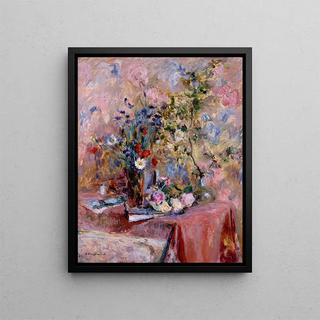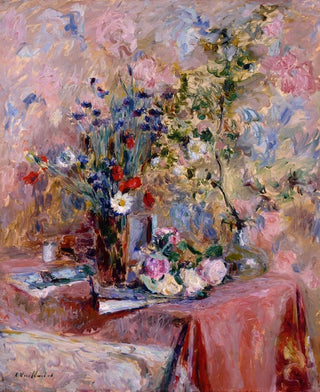Art print | Flowers - Édouard Vuillard


View from behind

Frame (optional)
In the world of art, some works manage to capture the very essence of nature's fleeting beauty. "Fleurs - Édouard Vuillard" is one such creation, where the artist invites us to contemplate a suspended moment, a vibrant bouquet of colors and textures. This piece, imbued with poetry, evokes not only the splendor of flowers but also the intimacy of bourgeois interiors from the late 19th century. Vuillard, a member of the Nabi movement, transcends mere representation to offer a rich sensory experience, where each petal seems to whisper secrets of domestic life.
Style and uniqueness of the work
Vuillard's style is distinguished by his innovative approach to color and composition. In "Fleurs," he uses shimmering hues and delicate patterns, creating a warm and welcoming atmosphere. The way he overlays colors, playing with light and shadow, gives the artwork unprecedented depth. The flowers, although static, seem to vibrate with a life of their own, as if they are about to bloom before our eyes. His bold use of textures, through brushstrokes that are both light and assertive, adds a tactile dimension to the canvas, allowing the viewer to almost feel the softness of the petals. This unique approach makes "Fleurs" an iconic work that perfectly illustrates the spirit of the Nabi, aiming to express emotions rather than faithfully reproduce reality.
The artist and his influence
Édouard Vuillard, a major figure of modern art, knew how to leave his mark on his era with his singular artistic vision. Born in 1868, he was influenced by the Nabi movement, which advocated a more personal and symbolic approach to art. Vuillard, along with contemporaries such as Pierre Bonnard, explored themes of intimacy and daily life, transforming ordinary scenes into true works of art. His influence extends beyond his time, inspiring many contemporary artists who seek to capture the essence of domestic life and human emotions. Through "Fleurs," Vuillard reminds us of the importance of the

Matte finish

View from behind

Frame (optional)
In the world of art, some works manage to capture the very essence of nature's fleeting beauty. "Fleurs - Édouard Vuillard" is one such creation, where the artist invites us to contemplate a suspended moment, a vibrant bouquet of colors and textures. This piece, imbued with poetry, evokes not only the splendor of flowers but also the intimacy of bourgeois interiors from the late 19th century. Vuillard, a member of the Nabi movement, transcends mere representation to offer a rich sensory experience, where each petal seems to whisper secrets of domestic life.
Style and uniqueness of the work
Vuillard's style is distinguished by his innovative approach to color and composition. In "Fleurs," he uses shimmering hues and delicate patterns, creating a warm and welcoming atmosphere. The way he overlays colors, playing with light and shadow, gives the artwork unprecedented depth. The flowers, although static, seem to vibrate with a life of their own, as if they are about to bloom before our eyes. His bold use of textures, through brushstrokes that are both light and assertive, adds a tactile dimension to the canvas, allowing the viewer to almost feel the softness of the petals. This unique approach makes "Fleurs" an iconic work that perfectly illustrates the spirit of the Nabi, aiming to express emotions rather than faithfully reproduce reality.
The artist and his influence
Édouard Vuillard, a major figure of modern art, knew how to leave his mark on his era with his singular artistic vision. Born in 1868, he was influenced by the Nabi movement, which advocated a more personal and symbolic approach to art. Vuillard, along with contemporaries such as Pierre Bonnard, explored themes of intimacy and daily life, transforming ordinary scenes into true works of art. His influence extends beyond his time, inspiring many contemporary artists who seek to capture the essence of domestic life and human emotions. Through "Fleurs," Vuillard reminds us of the importance of the






